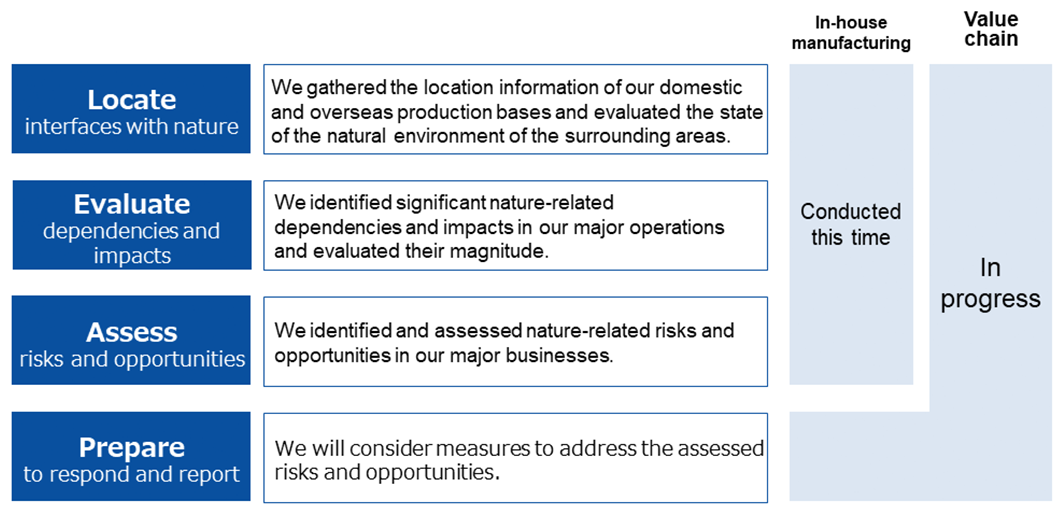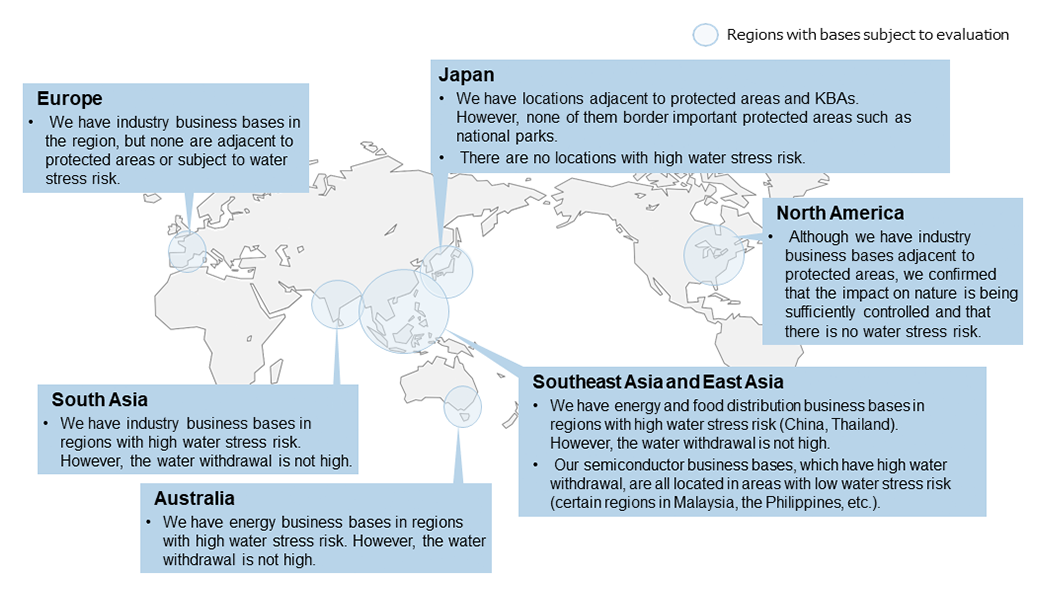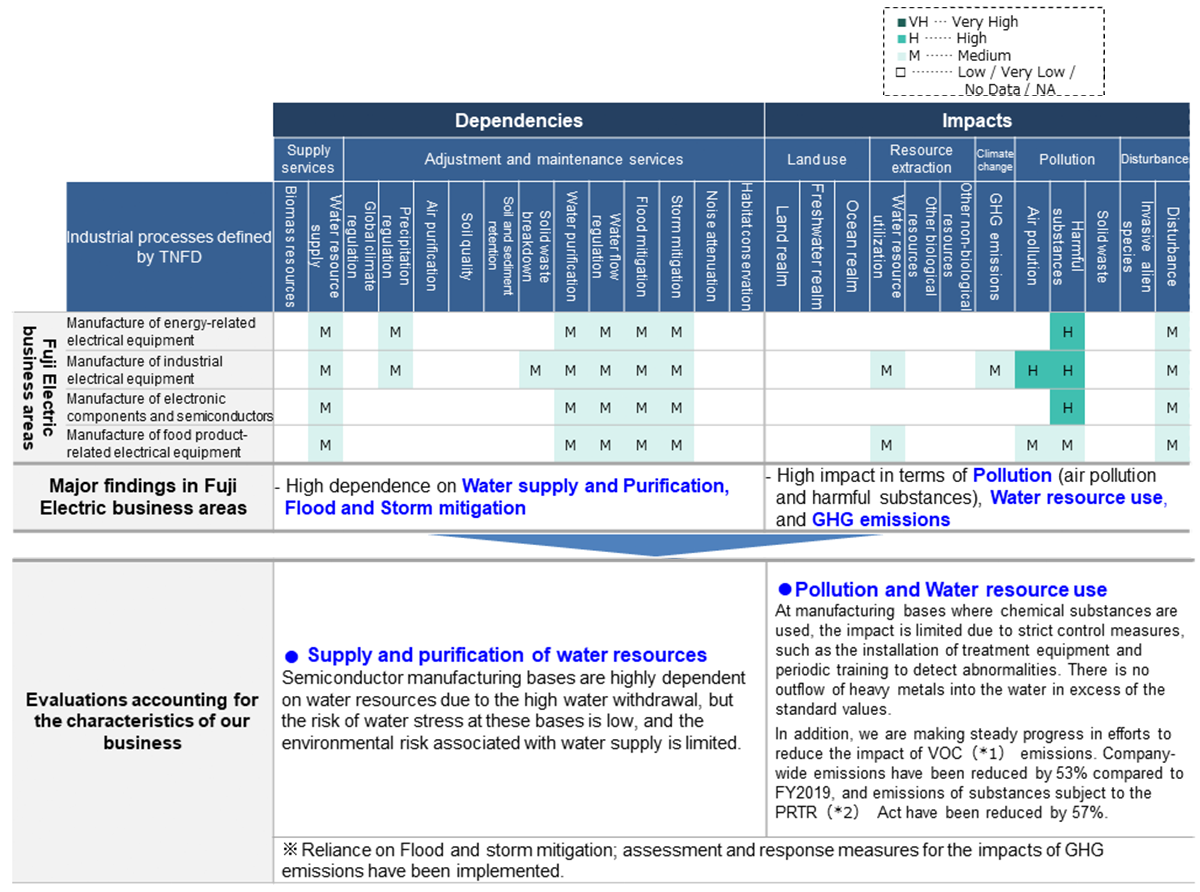Sustainability
Disclosing Nature-related Information based on TNFD Recommendations
In line with its Environmental Vision 2050, Fuji Electric aims to realize a society in harmony with nature. Through its energy and environment businesses, Fuji Electric is working to reduce environmental impact and contribute to the conservation of natural capital, including biodiversity. With the adoption of the Kunming-Montreal Global Biodiversity Framework in 2022, societal momentum toward a nature-positive world is building.
In light of this, Fuji Electric followed the framework of the Taskforce on Nature-related Financial Disclosures (TNFD) to evaluate its dependence on natural capital and the impact of its business activities on natural capital, as well as the risks and opportunities in its operations. We will continue our efforts to reduce environmental impact, which include global warming countermeasures, resource recycling, and chemical substance management, as well as initiatives to contribute to the conservation of biodiversity.
Governance
Fuji Electric regards protecting the global environment as a key management priority.
Twice a year, the executive officers of Fuji Electric's business, sales, and corporate divisions discuss and assess key sustainability-related challenges at the Sustainability Committee (formerly the SDGs Promotion Committee). These challenges include the advancement of Environmental Vision 2050, which includes measures to address natural capital issues, and the promotion of human rights and human resource engagement. Key items discussed by this committee are finalized by the Executive Committee and reported to the Board of Directors.
Strategy
We conduct assessments of nature-related risks and opportunities in line with the LEAP approach recommended by the TNFD. This year, we evaluated our major businesses—energy, industry, semiconductors, and food distribution—by identifying the nature-related dependencies and impacts associated with in-house manufacturing, as well as risks and opportunities.
Evaluation Process Under the LEAP Approach

Evaluating Priority Regions ("Locate”)
Based on five criteria recommended by the TNFD, including physical water risk, conservation priority, and ecosystem integrity, we evaluated 44 domestic and overseas manufacturing sites using data obtained through external tools.
-
(Note 1)
-
Ecosystem Integrity: An indicator of changes in species populations known as the Biodiversity Intactness Index. Higher values indicate areas with less human impact.
-
(Note 2)
-
KBA: Key Biodiversity Area: A key area for biodiversity conservation, selected based on globally standardized criteria for the conservation of rare species and ecosystems.
Results of Evaluations of Fuji Electric Manufacturing Sites
Evaluation of Physical Water Risk and Conservation Priority by Manufacturing Base

Evaluating Dependencies and Impacts ("Evaluate”)
We identified nature-related dependencies and impacts in our electrical equipment manufacturing business and evaluated their magnitude.
We used ENCORE, a tool recommended by the TNFD, to conduct evaluations, and organized the results in the form of a heat map.
Based on the results, we conducted an evaluation in light of the characteristics of our business.

(Note 1)
Volatile organic compounds
(Note 2)
A law for preventing environmental pollution caused by chemical substances, requiring business operators to report to the government the amount of chemical substances released and transferred
Assessing Risks and Opportunities (“Assess”)
Based on the assessment results of dependencies and impacts, we classified risks arising from the deterioration of the natural capital on which we depend as physical risks, while risks arising from social transformations toward greater emphasis on reducing negative impacts on nature and conserving biodiversity are classified as transition risks. We also identified opportunities in our areas of focus, through which we aim to achieve a recycling-oriented society and a society in harmony with nature, as stated in Environmental Vision 2050.
Going forward, we will consider measures to address these important risks and opportunities, and expand the scope of our assessments to encompass the entire value chain.
Managing the Impact of Risks
In line with the Fuji Electric Risk Management Rules, each division and affiliate of Fuji Electric systematically and organizationally manages risks, and annually assesses and evaluates risks associated with business activities. Topics of evaluation include climate change and environmental pollution. The evaluated risks are subject to an interim follow-up after the end of the second quarter and a final assessment at the end of the fiscal year.
Indicators and Targets
Fuji Electric carries out monitoring based on indicators it has established pertaining to water resources, on which we are highly dependent, as well as pollution, which involves significant impact. In addition, we have set targets for indicators that we consider important.
